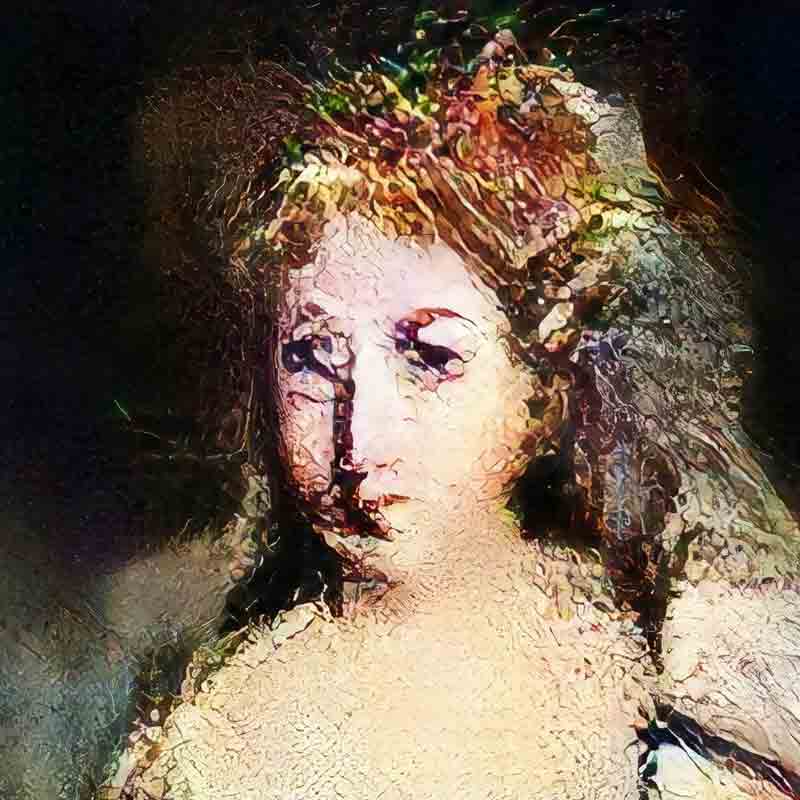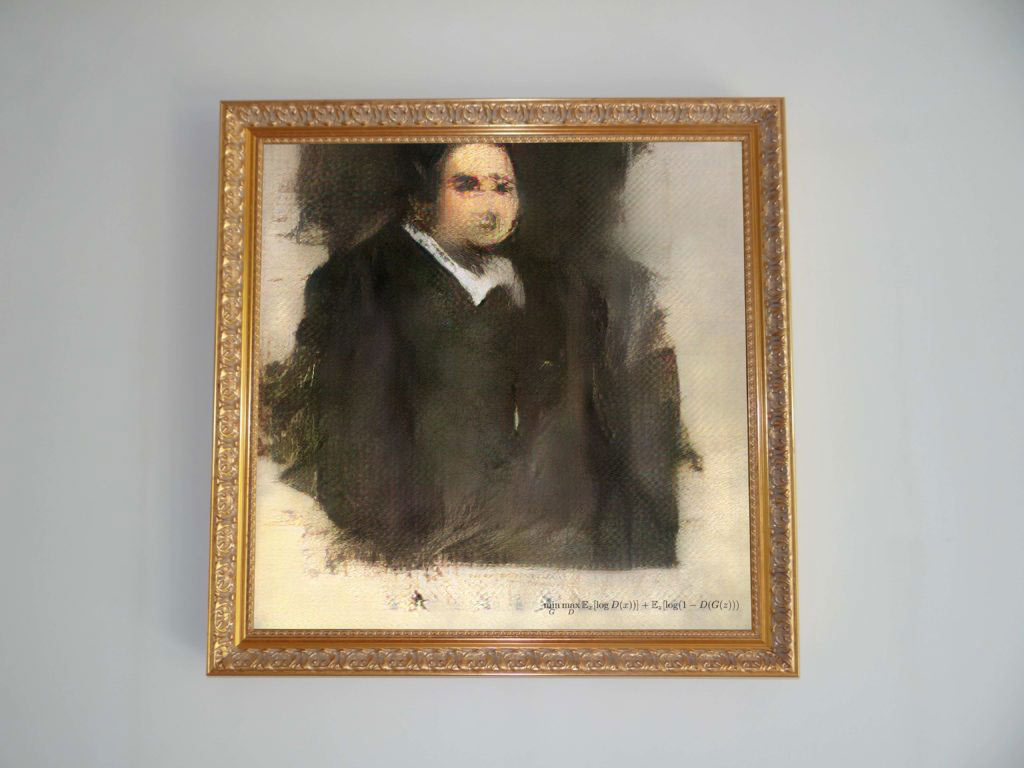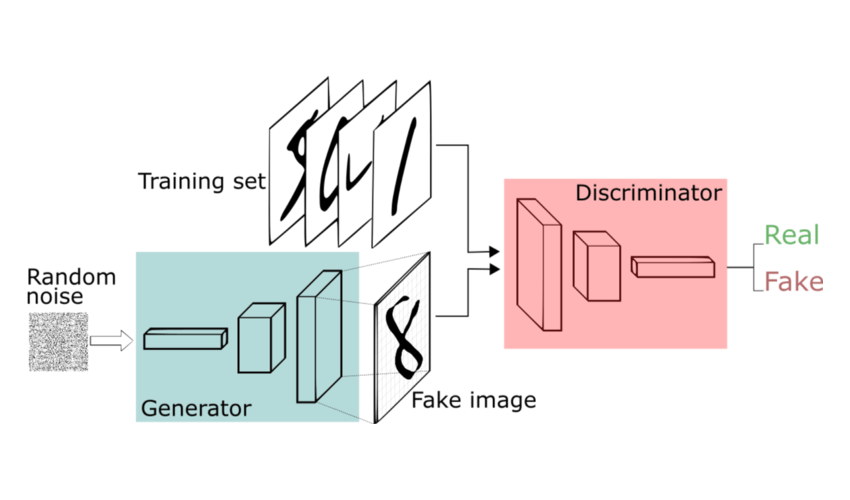
Art is a diverse range of activities in creating visual, auditory or performing artifacts.
They can be created with the author expressing his/her imaginative, conceptual idea, or technical skill. All that to create a result which is intended to be appreciated for their beauty or emotional power.
Art can be created because the author is human, thus having emotions to be expressed. Obvious wants to change that perception, by showing that computers too, can create art.
At Christie’s Central London Gallery, hangs inside a gold frame on a wall, a moody portrait of a man in Puritan-style black clothes with white collar, portrayed somewhere is an uncanny valley.
At the bottom where paintings usually put their painter's name, there is:
min G max D Ex [log (D(x))] + Ez [log (1 - D(G(z)))]
The art is called Edmond de Belamy, created by French art collective Obvious. The mathematical equation shows that the art is created by algorithms.

"The whole process is about humans having as little input as possible in the finished piece," explained Gauthier Vernier, one of three French men who founded Obvious in April 2017.
Vernier and his team has been teaching a computer about art history, and teaching it how to make its own artwork.
As of the announcement, Obvious have produced 11 artworks with the help of artificial intelligence.
Obvious sold its first piece, Le Comte de Belamy to a Paris-based collector Nicolas Laugero-Lasserre for €10,000 ($11,430).
With the money, the collective said that it is continuing the effort to train the algorithms, and finance the computational power needed to make such works, as well as experiment with 3D modeling.
Obvious also has plans to play with specific styles like impressionism, and experiment with samples from different cultures to create new images.
The team's motto for the AI, is "Creativity isn’t just for humans."
After the team behind Obvious coded the networks to fit their own criteria, they used Generative Adversarial Networks (GANs) to train the computer. These are AI algorithms used in unsupervised machine learning, implemented by a system of two neural networks contesting with each other.
The team fed the GAN algorithms with a collected set of 15,000 portraits from online art encyclopedia WikiArt, spanning from the 14th to the 19th century.
The GAN's first neural network is called the generator. It learned the ‘rules’ of the portraits, "for example, everything has two eyes and a nose," said Hugo Caselles-Dupré, a PhD student of AI who works on Obvious. This initial learning process takes about two days.
After that, the generator starts creating new images based on those predetermined rules. This is where the second neural network comes to play. Called the discriminator, its job is to review the images and guess which of them are 'real' from the dataset, and which are ‘fake ones' from the generator.
The generator and the discriminator are pitted against each other. The generator's job is to fool the discriminator, by learning with each failure. As time passed, the generator became smarter in which it was able to fool the discriminator.
When the process finished, Obvious was presented with a new image, not just a copy or an amalgamation of the existing 15,000 images. "Think of it as the 15,001st image," said Caselles-Dupré. "It’s an original image. That’s what’s so cool." The team his art movement "GAN-ism."

With the artworks, they have proven that computers can indeed create arts in ways similar to humans. But how can this be true as computers have no emotional feelings? Richard Lloyd, head of International Head of Prints and Multiples at Christies, tried explaining that, by saying:
"Everybody has their own definition of a work of art," he says. "I’ve tended to think human authorship was quite important—that link with someone on the other side. But you could also say art is in the eye of the beholder. If people find it emotionally charged and inspiring then it is. If it waddles and it quacks, it’s a duck."
Pierre Fautrel, another Obvious co-founder, puts it using his own words, saying that "One thing about our art is that nobody is indifferent to it. People either love it or really like it, or basically hate it. But nobody says whatever."
Obvious named their first works "Belamy", which is a rough translation of Goodfellow, in tribute to him. The 'Belamy family' here includes:
Le Comte, La Comtesse, Le Duc, Le Duchesse, Le Baron, Le Baronne, Le Marquis, L'Archeveque, Cardinal, Madame and La Baronne de Belamy.
The reason why the team showcased Obvious' work at the museum, is because "the first thing most people think of when they think of art, which is a old-looking portraits in a museum with a golden frame," explained Vernier. "We wanted to use these parallels, to stress the connection with ‘proper art,’ because we don’t just want to do graphic design or creative coding."
Obvious isn’t the only one working on AI Art. Some includes the Art and AI research Institute at Rutgers University in New Jersey which have been experimenting with it since 2012, and Robbie Barrat who was praised on Twitter for his AI-generated ‘nudes’.
